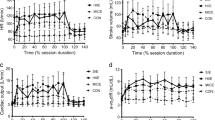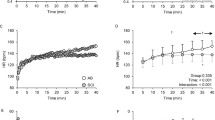Abstract
This study examined excess post-exercise oxygen consumption (EPOC) following arm cranking in men who had a traumatic spinal cord injury (SCI). Six physically active SCI men with a lesion level between T10 and T12 and six able-bodied (AB) men who were matched according to upper body peak VO2 performed 30 min of arm-cranking at 65–70% peak VO2. Baseline measurements were recorded during the last 10 min of a 40-min seated rest. Subjects remained seated during recovery for 40 min or until VO2 returned to baseline, whichever was longer. Plasma lactate concentration was measured at rest, at the end of exercise, and at 10, 20 and 40 min of recovery. EPOC duration was not significantly different (P>0.05) between SCI [23.2 (7.9) min; mean (SE)] and AB [35.0 (15.4) min] men, nor was there a significant group difference in EPOC magnitude [36.8 (7.8) kJ for SCI and 53.0 (22.8) kJ for AB]. There was no significant difference in recovery heart rate (HR) or respiratory exchange ratio (RER) between SCI and AB. However, HR measured at the end of the EPOC period was significantly elevated (P<0.001) and RER significantly lower (P<0.03) for both groups when compared to baseline. Lactate concentration was not significantly different between the groups at any sampling period. The findings suggest that physically active SCI men have a similar energy expenditure and time frame for recovery from arm crank exercise as their AB counterparts. Similar to what has been reported following lower body exercise, arm crank exercise elicits a higher HR and lower RER at end-EPOC when compared to pre-exercise values.

Similar content being viewed by others
References
Bahr R (1992) Excess post-exercise oxygen consumption—magnitude, mechanisms and practical implications. Acta Physiol Scand 144 [Suppl 605]:3–70
Bahr R, Hansson P, Sejersted OM (1990) Triglyceride/fatty acid cycling is increased after exercise. Metabolism 39:993–999
Bahr R., Hostmark AT, Newsholme EA, Gronnerod O, Sejersted OM (1991) Effect of exercise on recovery changes in plasma levels of FFA, glycerol, glucose and catecholamines. Acta Physiol Scand 143:105–115
Brehm BA, Gutin B (1986) Recovery energy expenditure for steady-state exercise in runners and nonexercisers. Med Sci Sports Exerc 18:205–210
Cowell LL, Squires WG, Raven PB (1986) Benefits of aerobic exercise for the paraplegic: a brief review. Med Sci Sports Exerc 18:501–508
Cunningham JJ (1980) A reanalysis of the factors influencing basal metabolic rate in normal adults. Am J Clin Nutr 33:2372–2374
Davis GM, Shephard RJ (1988) Cardiorespiratory fitness in highly active versus inactive paraplegics. Med Sci Sports Exerc 20:463–468
Fitzgerald PI, Sedlock DA, Knowlton RG (1990) Circulatory and thermal adjustments to prolonged exercise in paraplegic women. Med Sci Sports Exerc 22:629–635
Gass GC, Camp EM (1979) Physiological characteristics of trained Australian paraplegic and tetraplegic subjects. Med Sci Sports Exerc 11:256–259
Gass GC, Camp EM (1985) The maximum physiological responses during incremental wheelchair and arm cranking exercise in male paraplegics. Med Sci Sports Exerc 16:355–359
Gass GC, Camp EM, Davis HA, Eager D, and Grout L (1981) The effects of prolonged exercise on spinally injured subjects. Med Sci Sports Exerc 13:277–283
Glaser RM (1985) Exercise and locomotion for the spinal cord injured. In: Terjung RL (ed) Exercise and sport sciences reviews. Macmillan, New York, pp 263–303
Harris JA, Benedict FG (1919) Biometric studies of basal metabolism in man. Carnegie Institute of Washington, Washington DC, Publication no. 279
Hoffman MD (1986) Cardiorespiratory fitness and training in quadriplegics and paraplegics. Sports Med 3:312–330
Hopman MTE, Oeseburg B, Binkhorst RA (1993) Cardiovascular responses in persons with paraplegia to prolonged arm exercise and thermal stress. Med Sci Sports Exerc 25:577–583
Huonker M, Schmid A, Sorichter S, Schmidt-Trucksab A, Mrosek P, Keul J (1998) Cardiovascular differences between sedentary and wheelchair-trained subjects with paraplegia. Med Sci Sports Exerc 30:609–613
Mertler CA, Vannatta RA (2001) Advanced and multivariate statistical methods. Pyrczak, Los Angeles, p 11
Mollinger LA, Spurr GB, El Ghatit AZ, Barboriak JJ, Rooney CB, Davidoff DD, Bongard RD (1985) Daily energy expenditure and basal metabolic rate of patients with spinal cord injury. Arch Phys Med Rehabil 66:420–426
Sawka MN (1986) Physiology of upper body exercise. In: Pandolf KB (ed) Exercise and sport sciences reviews. Macmillan, New York, pp 175–211
Sedlock DA (1991a) The effect of acute nutritional status on postexercise energy expenditure. Nutr Res 11:735–742
Sedlock DA (1991b) Post-exercise energy expenditure following upper body exercise. Res Q Exerc Sport 62:213–216
Sedlock DA (1992) Post-exercise energy expenditure after cycle ergometer and treadmill exercise. J Appl Sport Sci Res 6:19–23
Sedlock DA, Laventure SJ (1990) Body composition and resting energy expenditure in long term spinal cord injury. Paraplegia 28:448–454
Sedlock DA, Fissinger JA, Melby CL (1989) Effect of exercise intensity and duration on postexercise energy expenditure. Med Sci Sports Exerc 21:662–666
Short KR, Sedlock DA (1997) Excess post-exercise oxygen consumption and recovery rate in trained and untrained subjects. J Appl Physiol 83:153–159
Short KR, Wiest JM, Sedlock DA (1996) The effect of upper body exercise intensity and duration on post-exercise oxygen consumption. Int J Sports Med 17:559–563
Wells CL, Hooker SP (1990) The spinal injured athlete. Adapt Phys Act Q 7:265–285
Acknowledgements
Sincere appreciation is extended to the subjects for their participation and to Clint Manwaring, Chris Lane, and Dr. Norman Morris for their technical support. We are also grateful to Carmel Williams for her assistance with subject recruitment.
Author information
Authors and Affiliations
Corresponding author
Rights and permissions
About this article
Cite this article
Sedlock, D.A., Schneider, D.A., Gass, E. et al. Excess post-exercise oxygen consumption in spinal cord-injured men. Eur J Appl Physiol 93, 231–236 (2004). https://doi.org/10.1007/s00421-004-1205-3
Accepted:
Published:
Issue Date:
DOI: https://doi.org/10.1007/s00421-004-1205-3




